50 cents
Lorem ipsum dolor sit amet, consectetuer adipiscing elit. Quisque sed felis. Aliquam sit amet felis. Mauris semper, velit semper laoreet dictum, quam diam dictum urna, nec placerat elit nisl in quam. Etiam augue pede, molestie eget, rhoncus at, convallis ut, eros. Aliquam pharetra. Nulla in tellus eget odio sagittis blandit. Maecenas at nisl. Nullam lorem mi, eleifend a, fringilla vel, semper at, ligula. Mauris eu wisi. Ut ante dui, aliquet nec, congue non, accumsan sit amet, lectus. Mauris et mauris. Duis sed massa id mauris pretium venenatis. Suspendisse cursus velit vel ligula. Mauris elit. Donec neque. Phasellus nec sapien quis pede facilisis suscipit. Aenean quis risus sit amet eros volutpat ullamcorper. Ut a mi. Etiam nulla. Mauris interdum. Read More →
Remedy Games
Lorem ipsum dolor sit amet, consectetuer adipiscing elit. Quisque sed felis. Aliquam sit amet felis. Mauris semper, velit semper laoreet dictum, quam diam dictum urna, nec placerat elit nisl in quam. Etiam augue pede, molestie eget, rhoncus at, convallis ut, eros. Aliquam pharetra. Nulla in tellus eget odio sagittis blandit. Maecenas at nisl. Nullam lorem mi, eleifend a, fringilla vel, semper at, ligula. Mauris eu wisi. Ut ante dui, aliquet nec, congue non, accumsan sit amet, lectus. Mauris et mauris. Duis sed massa id mauris pretium venenatis. Suspendisse cursus velit vel ligula. Mauris elit. Donec neque. Phasellus nec sapien quis pede facilisis suscipit. Aenean quis risus sit amet eros volutpat ullamcorper. Ut a mi. Etiam nulla. Mauris interdum. Read More →
The European Central Bank, on the other hand, is expected by some to signal the next interest rate hike at its rate setting meeting scheduled for tomorrow. Some analysts point out, however, that recent comments from ECB officials suggest that the central bank would prefer to take a wait-and-see stance, fearful that a hike could do more harm to fiscally troubled peripheral states. The Euro was trading against the U.S. Dollar at $1.4826, only slightly off the $1.4902 17-month peak struck on Monday. Since February, the Euro has gained nearly 11% on the greenback, with divergent rate expectations from the respective central banks underpinning sentiment.
http://www.dailyforex.com/forex-news/2011/05/Pound-Sterling-Drops-as-Interest-Rate-Hike-Expectations-Fade/7821
The release earlier of Chinese data on retail sales and industrial production, both below analysts’ expectations, pushed risk sensitive currencies lower, with the Australian Dollar and the Euro falling briefly before recovering. That recovery bolstered the Aussie, which was trading at $1.0860 against the greenback, a rise of 0.2% during the trading session.
The Euro did receive some support yesterday when the media reported that another bailout plan for Greece was in the works; while the government denied the claim, most investors recognize that the options available to Greece are limited and a new aid package is the lesser of all evils, considering that other options include debt restructuring or the exit from the Eurozone which many believe could be devastating for the Eurozone economy in the long run.
http://www.dailyforex.com/forex-news/2011/05/Euro-Holds-Onto-Gains-as-Commodities-Steady/7869
The Australian Dollar, considered a high risk currency, has become popular among investors who recently helped send the Aussie higher against the U.S. Dollar to $1.1011, the highest price in 29 years. In earlier Asian trading today, the Aussie edged lower to $1.0929, as market players await the outcome of the RBA’s policy setting meeting. Most analysts agree that the central bank will leave rates unchanged, but will closely scrutinize the tone of the announcement for a key to likely direction given last week’s inflation report, which was higher than expected. If the RBA sounds hawkish on inflationary pressures, analysts say the barrier of $1.11 is likely to fall.
http://www.dailyforex.com/forex-news/2011/05/USD-Index-Slightly-Higher-even-as-bin-Laden-Euphoria-Wanes/7812
Yesterday, the Standard & Poor’s credit rating agency cut Greece’s rating again, dropping it from BB- to B, essentially considered junk status. S&P further noted that it was likely that Greece’s debt burden was unsustainable without a debt haircut. In spite of last year’s bailout, Greece’s economy continues to struggle out of a deep recession, and speculation is swirling that even a new, more favorable rescue package will be unlikely to help.
On a positive note, analysts don’t believe that the Greek fiscal tragedy will have the same detrimental effect on the Euro as it did last year, given that a safety net is now available to heavily indebted countries in the Eurozone.
http://www.dailyforex.com/forex-news/2011/05/Euro-Edges-Higher-But-Pressure-Still-Seen-from-Greece/7864
As reported at 2:00 p.m. (JST) in Tokyo, the Euro traded against the greenback at $1.4860, up from $1.4827 traded in New York late yesterday; it approached $1.4940 at one point, the highest price since late 2009. Against the Japanese Yen, the Euro traded at 119.44 Yen, up from 119.55 Yen.
What is expected at today’s ECB meeting is that Jean-Claude Trichet, the ECB President, will once again highlight the risks of inflation and its links to energy, commodity and food prices. It is further expected that he will discuss exactly how quickly the ECB is willing to raise interest rates to combat inflationary pressures at the risk of putting further pressure on the Eurozone’s fiscally troubled states.
http://www.dailyforex.com/forex-news/2011/05/Euro-Moves-Higher-Ahead-of-ECB-Policy-Meeting/7835
With the divergence of the U.S. central bank’s monetary policy from most other central banks clearly being seen, the U.S. currency has no where else to go but down. Against the Euro, analysts say the greenback is targeting $1.50; in today’s Asian trading the greenback fell to a new 17-month low of $1.4882 on the EBS trading platform before easing back to $1.4858. Likewise, the U.S. Dollar fell against the Australian Dollar, touching on new record lows; analysts see $1.10 as a likely near target.
The Fed Chairman’s historic first press conference apparently was intended to lay the framework for further easing measures by the central bank. The current quantitative easing scheme is scheduled to end in June, and some analysts believe that a third round of bond purchases is likely given that the U.S. economy has not significantly improved.
http://www.dailyforex.com/forex-news/2011/04/Fallout-from-Fed-Press-Conference-US-Dollar-Slips-Lower/7787
One trader in Japan said that the Greek rumor triggered the Euro’s decline, but that long Euro positioning is still what is driving the market. That was confirmed by the U.S. CFTC (Commodity Futures Trading Comm.) which released data that showed that long position contracts in the common currency rose to its highest level in nearly four years to 99,516 contracts, a significant increase from the previous week’s 68,279 contracts.
Whether or not the Euro’s decline will continue is unclear; the common currency recently fell below a key support level. The ongoing crises there continue to put pressure on the Euro and the recent Greek rumor will likely be investigated further to determine its credibility.
http://www.dailyforex.com/forex-news/2011/05/Euro-Rebounds-after-3-Week-Low/7854
In retrospect, it's easy to notice that in December of 2003 when President George Bush announced the terrorist’s capture, both the Dow and the S&P rallied, indicating a strengthening of the Dollar. This rally was relativel short-lived, however, as the currency began to decline again only a few weeks later. The takeaway from this incident should not be ignored.
The U.S. Dollar and the Death of Bin Laden
The U.S. Dollar Index finally rose off a 3-year low, and all it took was news of the death of Osama bin Laden, the leader of the radical al Qaeda faction. Most traders agree that the gain is likely a knee-jerk reaction and the dollar will revert before too long. As reported at 2:38 p.m. (JST) in Tokyo, the U.S. Dollar Index traded at 73.152 .DXY, a gain of 0.2%, coming off a 3-year low of 72.813 .DXY struck earlier in the session. In April, the Dollar Index lost nearly 4%, and traders say that it appears that the U.S. currency has been oversold in the short term, so a correction was expected.The prevailing perception is that the U.S. Federal Reserve’s monetary policy will remain in place for an extended period, and thus the U.S. Dollar will continue to be under downward pressure. This was highlighted last week when the Commodity Futures Trading Commission (CFTC) released a report which showed that currency speculators increased their bets against the U.S. Dollar during the previously ended week.
The U.S. Dollar was higher against the common currency Euro, gaining 0.1% to trade at $1.4792; the Australian Dollar also fell against the greenback, slipping 0.2% after touching on a 29-year peak of $1.1011.
http://www.dailyforex.com/forex-news/2011/05/Death-of-bin-Laden-Sends-US-Dollar-High-in-Asian-Trading/7805
According to one strategist in Japan, the Reserve Bank’s Monetary Policy Statement, issued earlier in the trading day, was more hawkish than the market had been expecting, helping to boost risk appetite. In the statement, the Australian central bank left their economic growth estimate unchanged from the February forecast at 4.25% for the remainder of the year. They expect consumer prices to rise higher than the previous 3% forecast to 3.25%, with core inflation expected to accelerate to 3% from the 2.75% forecast. The outlook also noted that further monetary policy tightening is likely in order to keep inflation consistent. The bank’s target inflation goal is 2 to 3% in the medium term.
http://www.dailyforex.com/forex-news/2011/05/Reserve-Bank-of-Australia-Takes-Hawkish-Tone-Sends-Aussie-Higher/7846
Investor sentiment for the U.S. Dollar is seen as dwindling with the Federal Reserve’s recent reassurance that the central bank has no timetable for tightening the current easy money monetary policy. In support of the Fed’s stance, it was yesterday reported that the U.S. economy saw only minimal growth in the first quarter, while initial claims for unemployment benefits were higher than analysts’ had previously forecast.
The common currency Euro gained 0.2% against the U.S. Dollar trading at $1.4846, close to the 17-month high of $1.4882 struck yesterday on the EBS trading platform. Analysts say resistance is pegged at $1.4906. The Australian Dollar, however, fell against the greenback trading at $1.0901, a decline of 0.3%, yet still within striking distance of a 29-year high of $1.0948.
http://www.dailyforex.com/forex-news/2011/04/US-Dollar-Continues-Downward-Spiral/7794
The European Central Bank, on the other hand, is expected by some to signal the next interest rate hike at its rate setting meeting scheduled for tomorrow. Some analysts point out, however, that recent comments from ECB officials suggest that the central bank would prefer to take a wait-and-see stance, fearful that a hike could do more harm to fiscally troubled peripheral states. The Euro was trading against the U.S. Dollar at $1.4826, only slightly off the $1.4902 17-month peak struck on Monday. Since February, the Euro has gained nearly 11% on the greenback, with divergent rate expectations from the respective central banks underpinning sentiment.
http://www.dailyforex.com/forex-news/2011/05/Pound-Sterling-Drops-as-Interest-Rate-Hike-Expectations-Fade/7821
In Asian trading today, the U.S. Dollar slipped broadly lower as markets ponder the likely outcome of today’s Federal Open Market Committee Meeting. As reported at 3:39 p.m. (JST) in Tokyo, the greenback traded against the Australian Dollar at $1.0853, the lowest trade in 29 years. While against the safe haven Swiss Franc, the U.S. Dollar dropped to a record low 0.8669 Swiss Francs. The U.S. Dollar Index, which measures the greenback’s strength vis-à-vis a weighted basket of major currencies, touched on a 3-year low of 73.493 .DXY earlier and traders expect that the record low of 70.698 .DXY is likely soon to be struck.
The majority of market players are speculating that the Federal Reserve’s current loose monetary policy will continue for the near term as the Fed works to revive the U.S. economy. What is of paramount concern to markets and analysts alike is how the Fed will exit their current quantitative easing scheme, which is scheduled to conclude at the end of this quarter. Fiscal problems in the U.S. are also playing a role in the greenback’s weakening, with a significant budget deficit and a debt ceiling that is likely to be hit as soon as next month.
Meanwhile, the common currency Euro continues to benefit from decisive and aggressive monetary policy in the Eurozone, even as troubled member nations there continue to struggle with debt. Earlier, the Euro was trading higher against the U.S. Dollar at $1.4715, breaking through the $1.47 barrier established in December 2009.
http://www.dailyforex.com/forex-news/2011/04/US-Dollar-Falls-Ahead-of-FOMC-Meeting/7774
The Australian Dollar, considered a high risk currency, has become popular among investors who recently helped send the Aussie higher against the U.S. Dollar to $1.1011, the highest price in 29 years. In earlier Asian trading today, the Aussie edged lower to $1.0929, as market players await the outcome of the RBA’s policy setting meeting. Most analysts agree that the central bank will leave rates unchanged, but will closely scrutinize the tone of the announcement for a key to likely direction given last week’s inflation report, which was higher than expected. If the RBA sounds hawkish on inflationary pressures, analysts say the barrier of $1.11 is likely to fall.
http://www.dailyforex.com/forex-news/2011/05/USD-Index-Slightly-Higher-even-as-bin-Laden-Euphoria-Wanes/7812
Speaking to reporters, Trichet commented that he didn’t see second-round inflation as a significant threat, comments which prompted some traders to dump their long positions in the common currency. Overall, however, most market players are certain that the greenback will be under pressure for the long term, given that the Federal Reserve is unlikely to alter its current ultra loose monetary policy.
http://www.dailyforex.com/forex-news/2011/04/Euro-Slips-in-Asian-Trading-as-Trichet's-Patience-with-US-Policy-Wanes/7762
As reported at 2:00 p.m. (JST) in Tokyo, the Euro traded against the greenback at $1.4860, up from $1.4827 traded in New York late yesterday; it approached $1.4940 at one point, the highest price since late 2009. Against the Japanese Yen, the Euro traded at 119.44 Yen, up from 119.55 Yen.
What is expected at today’s ECB meeting is that Jean-Claude Trichet, the ECB President, will once again highlight the risks of inflation and its links to energy, commodity and food prices. It is further expected that he will discuss exactly how quickly the ECB is willing to raise interest rates to combat inflationary pressures at the risk of putting further pressure on the Eurozone’s fiscally troubled states.
http://www.dailyforex.com/forex-news/2011/05/Euro-Moves-Higher-Ahead-of-ECB-Policy-Meeting/7835
With the divergence of the U.S. central bank’s monetary policy from most other central banks clearly being seen, the U.S. currency has no where else to go but down. Against the Euro, analysts say the greenback is targeting $1.50; in today’s Asian trading the greenback fell to a new 17-month low of $1.4882 on the EBS trading platform before easing back to $1.4858. Likewise, the U.S. Dollar fell against the Australian Dollar, touching on new record lows; analysts see $1.10 as a likely near target.
The Fed Chairman’s historic first press conference apparently was intended to lay the framework for further easing measures by the central bank. The current quantitative easing scheme is scheduled to end in June, and some analysts believe that a third round of bond purchases is likely given that the U.S. economy has not significantly improved.
http://www.dailyforex.com/forex-news/2011/04/Fallout-from-Fed-Press-Conference-US-Dollar-Slips-Lower/7787
Despite the continued chance of debt restructuring in Greece which threatens to wreak havoc on the regional economy, the Euro rallied to a 16-month high against the US dollar as speculation increased that the ECB will continue to raise interest rates this year.
Although last week’s trading was shortened due to Good Friday, this week’s global economy may fluctuate greatly as several upcoming events may impact the major currency pairs. Among the events to keep an eye on are:
Continued close of the markets in Australia, New Zealand and Europe for an extended Easter holiday today, Monday, April 25.
On Tuesday, April 26, Australia is scheduled to publish information about its economic indicators, which should offer an insight into the direction of AUD based Forex currency pairs.
On Wednesday, April 27, US Fed Chairman Ben Bernanke will hold a press conference which follows the banks’ rank-setting meeting.
On Thursday, April 28, the Bank of Japan will once again address the disasters that have shaken the country and will likely suggest additional measures of protection.
On April 29, Germany is expected to publish information about consumer price index and unemployment rates both within its borders and in the wider Eurozone.
http://www.dailyforex.com/forex-news/2011/04/Global-Markets-Closed-New-Reports-Expected/7753
In retrospect, it's easy to notice that in December of 2003 when President George Bush announced the terrorist’s capture, both the Dow and the S&P rallied, indicating a strengthening of the Dollar. This rally was relativel short-lived, however, as the currency began to decline again only a few weeks later. The takeaway from this incident should not be ignored.
The U.S. Dollar and the Death of Bin Laden
The U.S. Dollar Index finally rose off a 3-year low, and all it took was news of the death of Osama bin Laden, the leader of the radical al Qaeda faction. Most traders agree that the gain is likely a knee-jerk reaction and the dollar will revert before too long. As reported at 2:38 p.m. (JST) in Tokyo, the U.S. Dollar Index traded at 73.152 .DXY, a gain of 0.2%, coming off a 3-year low of 72.813 .DXY struck earlier in the session. In April, the Dollar Index lost nearly 4%, and traders say that it appears that the U.S. currency has been oversold in the short term, so a correction was expected.The prevailing perception is that the U.S. Federal Reserve’s monetary policy will remain in place for an extended period, and thus the U.S. Dollar will continue to be under downward pressure. This was highlighted last week when the Commodity Futures Trading Commission (CFTC) released a report which showed that currency speculators increased their bets against the U.S. Dollar during the previously ended week.
The U.S. Dollar was higher against the common currency Euro, gaining 0.1% to trade at $1.4792; the Australian Dollar also fell against the greenback, slipping 0.2% after touching on a 29-year peak of $1.1011.
http://www.dailyforex.com/forex-news/2011/05/Death-of-bin-Laden-Sends-US-Dollar-High-in-Asian-Trading/7805
According to one strategist in Japan, the Reserve Bank’s Monetary Policy Statement, issued earlier in the trading day, was more hawkish than the market had been expecting, helping to boost risk appetite. In the statement, the Australian central bank left their economic growth estimate unchanged from the February forecast at 4.25% for the remainder of the year. They expect consumer prices to rise higher than the previous 3% forecast to 3.25%, with core inflation expected to accelerate to 3% from the 2.75% forecast. The outlook also noted that further monetary policy tightening is likely in order to keep inflation consistent. The bank’s target inflation goal is 2 to 3% in the medium term.
http://www.dailyforex.com/forex-news/2011/05/Reserve-Bank-of-Australia-Takes-Hawkish-Tone-Sends-Aussie-Higher/7846
Investor sentiment for the U.S. Dollar is seen as dwindling with the Federal Reserve’s recent reassurance that the central bank has no timetable for tightening the current easy money monetary policy. In support of the Fed’s stance, it was yesterday reported that the U.S. economy saw only minimal growth in the first quarter, while initial claims for unemployment benefits were higher than analysts’ had previously forecast.
The common currency Euro gained 0.2% against the U.S. Dollar trading at $1.4846, close to the 17-month high of $1.4882 struck yesterday on the EBS trading platform. Analysts say resistance is pegged at $1.4906. The Australian Dollar, however, fell against the greenback trading at $1.0901, a decline of 0.3%, yet still within striking distance of a 29-year high of $1.0948.
http://www.dailyforex.com/forex-news/2011/04/US-Dollar-Continues-Downward-Spiral/7794
In Asian trading today, the U.S. Dollar slipped broadly lower as markets ponder the likely outcome of today’s Federal Open Market Committee Meeting. As reported at 3:39 p.m. (JST) in Tokyo, the greenback traded against the Australian Dollar at $1.0853, the lowest trade in 29 years. While against the safe haven Swiss Franc, the U.S. Dollar dropped to a record low 0.8669 Swiss Francs. The U.S. Dollar Index, which measures the greenback’s strength vis-à-vis a weighted basket of major currencies, touched on a 3-year low of 73.493 .DXY earlier and traders expect that the record low of 70.698 .DXY is likely soon to be struck.
The majority of market players are speculating that the Federal Reserve’s current loose monetary policy will continue for the near term as the Fed works to revive the U.S. economy. What is of paramount concern to markets and analysts alike is how the Fed will exit their current quantitative easing scheme, which is scheduled to conclude at the end of this quarter. Fiscal problems in the U.S. are also playing a role in the greenback’s weakening, with a significant budget deficit and a debt ceiling that is likely to be hit as soon as next month.
Meanwhile, the common currency Euro continues to benefit from decisive and aggressive monetary policy in the Eurozone, even as troubled member nations there continue to struggle with debt. Earlier, the Euro was trading higher against the U.S. Dollar at $1.4715, breaking through the $1.47 barrier established in December 2009.
http://www.dailyforex.com/forex-news/2011/04/US-Dollar-Falls-Ahead-of-FOMC-Meeting/7774
Analysts say market jitteriness is being soothed by upbeat earnings reports in the U.S. and Europe, and investor sentiment is leaning toward higher risk currencies as the market well absorbed earlier concerns over Greek debt and a U.S. debt downgrade.
One analyst noted that investors are favoring currencies which offer higher yields at the Dollar and Yen’s expense, and a recent rise in the Asian equity market highlights investors’ sentiment toward risk-taking. The U.S. Dollar rose against the Japanese Yen, gaining 0.4% to trade at 82.91 Yen. The Euro also gained against the Japanese currency, climbing nearly 0.8% to trade at 119.27 Yen, well off a 2-week low of 116.49 Yen struck on the EBS trading platform earlier in the week.
http://www.dailyforex.com/forex-news/2011/04/Euro-Rebounds-in-Asia-on-Interest-Rate-Hike-Speculation/7726
Speaking to reporters, Trichet commented that he didn’t see second-round inflation as a significant threat, comments which prompted some traders to dump their long positions in the common currency. Overall, however, most market players are certain that the greenback will be under pressure for the long term, given that the Federal Reserve is unlikely to alter its current ultra loose monetary policy.
http://www.dailyforex.com/forex-news/2011/04/Euro-Slips-in-Asian-Trading-as-Trichet's-Patience-with-US-Policy-Wanes/7762
The U.S. Dollar edged slightly lower against the Japanese Yen in Tokyo trading as investors pared away their carry trade positions, but most analysts expect that move will be short-lived with hedge fund operators and Japan-based life insurers positioning themselves ahead of what is likely to be another Yen slide. As reported at 3:13 p.m. (JST) in Tokyo, the U.S. Dollar slipped against the Yen to 82.42 Yen, off a 3-week trough of 82.19 Yen. Speculation is that Japanese hedge funds and life insurers will buy back the greenback for Treasury and debt purchases as and when it falls nearer to 82 Yen.
The Euro, yesterday, took a hard hit as investors’ fears resurfaced that Greek debt will need restructuring within the next few months, well ahead of the launch of the permanent stability mechanism. Also, the United States has been cautioned with a negative outlook by yet another ratings agency, this time Standard & Poors, that their current AAA credit rating is in jeopardy of being downgraded unless the deficit problem is addressed soon. One analyst said that while the negative outlook might have come as a jolt, it was really no surprise to anyone and that markets should absorb fairly well.
http://www.dailyforex.com/forex-news/2011/04/U.S.-Dollar-Lower-Against-Yen-as-Investors-Reposition-for-Yen-Slide/7720
The increase in higher risk assets is being attributed to robust corporate earnings from the United States, an indication that the global economy is moving forward in spite of the Federal Reserve’s stance that the current ultra loose policy is appropriate at this point in time. The outlook for the U.S. dollar remains dim in the long-term however, with investors worrying about the impact that a debt downgrade could have on the Fed’s ability to buy bonds at the currently low prices. The U.S. Dollar has been under pressure from the majority of currencies; against the Euro, it lost 0.7% to trade at $1.4612 after striking a low of $1.4618 on the EBS trading platform.
http://www.dailyforex.com/forex-news/2011/04/Investors-Shun-Safe-Havens-Sending-Dollar-Index-to-3-Year-Low/7736
The Australian dollar climbed to $1.0766, up from $1.0714 in New York yesterday, after reaching $1.0772, the strongest since it was freely floated in 1983. The Australian Dollar was at 88.33 yen from 88.45 yen, while the New Zealand’s dollar rose to 80.34 U.S. cents, up 0.7% the highest level since March 2008.
Analysts noted that the Australian Dollar has risen 3.8% in the past 6 months and has outperformed other dollar currencies, including the New Zealand dollar and the Canadian dollar. The country’s bonds, however, fell for the second consecutive day.
http://www.dailyforex.com/forex-news/2011/04/AUD-Reaches-Record-High/7734
Despite the continued chance of debt restructuring in Greece which threatens to wreak havoc on the regional economy, the Euro rallied to a 16-month high against the US dollar as speculation increased that the ECB will continue to raise interest rates this year.
Although last week’s trading was shortened due to Good Friday, this week’s global economy may fluctuate greatly as several upcoming events may impact the major currency pairs. Among the events to keep an eye on are:
Continued close of the markets in Australia, New Zealand and Europe for an extended Easter holiday today, Monday, April 25.
On Tuesday, April 26, Australia is scheduled to publish information about its economic indicators, which should offer an insight into the direction of AUD based Forex currency pairs.
On Wednesday, April 27, US Fed Chairman Ben Bernanke will hold a press conference which follows the banks’ rank-setting meeting.
On Thursday, April 28, the Bank of Japan will once again address the disasters that have shaken the country and will likely suggest additional measures of protection.
On April 29, Germany is expected to publish information about consumer price index and unemployment rates both within its borders and in the wider Eurozone.
http://www.dailyforex.com/forex-news/2011/04/Global-Markets-Closed-New-Reports-Expected/7753
The newest concern among market players is Finland, which last week’s regional elections sent the True Finns political party, considered anti-Euro by many political watchers, to the Finnish Parliament. According to the that government’s constitution, the Finnish parliament has the constitutional right to vote on all European Union requests for bailout assistance, suggesting it could hold up E.U. aid plans for Portugal specifically, as well as create instability, in general.
The only thing propping up the Euro at this point is that prospect that the European Central Bank will move to raise interest rates again following the recent data which showed Eurozone inflation rising higher to 2.7% as compared to the same period a year earlier; economists had expected an increase to 2.6% last month.
http://www.dailyforex.com/forex-news/2011/04/Eurozone-Debt-Worries-Resurface-to-Hold-Euro-Lower-vs-Dollar-Yen/7704
Market players are even more concerned that recovery of the U.S. economy could falter if the agreement between the President and the Legislature is insufficient to significantly reduce the deficit, either through tax hikes or spending cuts. Either or both could compel the U.S. Federal Reserve Bank to maintain their interest rates at the current historic low, even at a time when central banks throughout the world are raising interest rates to fight inflation.
Most analysts agree that the Dollar’s decline comes from the loss of investors’ confidence in U.S.-denominated assets, especially given the recent threat of a credit downgrade by Standard & Poors. Markets now seem to be measuring the impact of a U.S. debt downgrade, although they had well accepted and absorbed the announcement originally.
http://www.dailyforex.com/forex-news/2011/04/U.S.-Dollar-Index-Approaches-All-Time-Record-Low/7747
As reported at 2:46 p.m. (JST) in Tokyo, the Euro is trading against the greenback at $1.4472, edging back 0.1% from late Thursday trading in New York but still within striking distance of the $1.4521 peak struck earlier in the week. Most market players don’t believe the Euro will face difficulty rising above $1.45, especially given the Eurozone’s debt problems and with Irelands’ credit rating being downgraded earlier today.
Recent rhetoric from several Federal Reserve officials has increased investor speculation that the central bank’s ultra loose monetary policy is likely to remain as such for an extended length of time. Collectively, the position of the Fed is that inflation – and the subsequent hikes in the prices of commodities – remains transitory and manageable by the current policy. The European Central Bank, conversely, continues to closely watch inflationary pressures and acknowledges that it is ready to move again with additional interest rate hikes if the situation warrants.
http://www.dailyforex.com/forex-news/2011/04/Ireland-Downgrade-Only-Marginally-Affects-Euro/7698
As reported at 3:20 p.m. (JST) in Tokyo, the Yen fell against the Euro to 121.91 Yen on the EBS trading platform, an 11-month low. Against the Aussie, the Yen slipped 0.7%, trading at 88.27 Yen, while against the greenback the Yen slipped 0.5% to 83.50 Yen.
Beginning today through tomorrow, officials from the Bank of Japan will be meeting to discuss policy in the wake of the crisis. Most analysts expect that they will signal their willingness for further easing measures, if necessary.
http://www.dailyforex.com/forex-news/2011/04/Yen-Continues-to-Slip-Broadly-Lower-Under-G7-Manipulation/7620
The U.S. Dollar rose against the Japanese Yen in Tokyo trading today as pension fund operators in Japan, as well as Japanese importers, bought the greenback heavily. As reported at 3:04 p.m. (JST) in Tokyo, the U.S. Dollar was trading against the Yen at 84.04 Yen, up from the 83.59 Yen in New York trading late Tuesday. Earlier in the session, the Dollar had slipped close to the 200-month moving average of 83.50 Yen. The Euro was also higher against the Yen, trading at 121.67 Yen on the EBS trading platform, up from the 120.98 Yen trade late in New York yesterday. The Japanese Yen had been sent soaring in yesterday’s trade as safe haven investors pushed the currency higher following the announcement by the Japan Nuclear and Industrial Safety Agency that they had raised the threat rating of the Fukushima nuclear plant accident to a level equivalent to that of Chernobyl. Today’s absence of bad news, generally, is apparently driving risk appetite higher, sending the Yen lower again. Most analysts agree that the USD/JPY will be testing the upside for the near term. Later today, focus should shift to the U.S. where retail sales data is expected to be released; further on in the global day, the U.S. Federal Reserve’s Beige Book update will also be released, providing a behind-the-scenes indication of the U.S. economy’s direction. The U.S. Dollar Index, a gauge of the greenback’s value versus other major currencies, was recently at 79.906 .DXY, up from 74.863 .DXY.
http://www.dailyforex.com/forex-news/2011/04/Absence-of-Bad-News-Sends-Yen-Lower/7677
Elsewhere, the Euro held steady just below a 5-month peak versus the U.S. Dollar, as investors reassess their positions ahead of the ECB policy setting meeting to be held later this week. Most analysts expect that the European Central Bank will hike the current rate by 25 basis points to 1.25% in an attempt to stave off inflationary pressures in the Eurozone, driven primarily by higher commodity prices. Analysts are expecting that before year’s en, the ECB will have raised their benchmark rate to 1.75%. So far this year, the Euro has gained better than 6% against the greenback. Earlier, the Euro was trading against the U.S. Dollar at $1.4192. Further gains in the Euro are likely to be limited, given that rate hikes are already factored in.
http://www.dailyforex.com/forex-news/2011/04/Aussie-Dollar-Slips-Following-RBA-Rate-Decision/7613
In light of the recent disasters in Japan, the International Monetary Fund reduced its forecast for Japanese growth from 1.6 to 1.4. This behavior is typical for the Japanese currency during times of disaster. The IMF’s forecast for 2012 was raised from 1.8 percent to 2.1 percent.
http://www.dailyforex.com/forex-news/2011/04/Dollar-and-Yen-Strengthen-After-New-Earthquakes-Hit/7667
While the interest rate hike is not yet a done deal, many economists are suggesting that given the fiscal state of several of the Eurozone nations, i.e. Portugal, Spain, Greece, etc., an interest rate hike will be more harmful than good.
As reported at 2:57 p.m. (JST) in Tokyo, the Euro slipped against the U.S. Dollar, trading at $1.4297 following yesterday’s surge to $1.4350. Near term support is pegged around $1.4285 to $1.4250; some currency strategists say that if the Euro can’t rise well above $1.4282, it could retreat to near $1.4160. Against the Yen, the Euro was trading at121.77 Yen following yesterday’s 11-month peak. Most analysts agree that the long-term outlook for the Yen is on a downtrend.
http://www.dailyforex.com/forex-news/2011/04/As-ECB-Meeting-Looms-Euro-Falls/7631
The common currency Euro, on the other hand, is approaching highs against the U.S. Dollar, as investors speculate that the ECB will continue to tighten monetary policy following the recently implemented interest rate hike. As reported at 2:58 p.m. (JST) in Tokyo, the Euro gained nearly 0.5% to trade at $1.4508, close to the 15-month peak of $1.4521. The U.S. Dollar also fell lower against the Japanese Yen, trading at one point at 83.20 Yen on the EBS trading platform, and well off the 6½ month peak of 85.55 Yen struck last week. One FX strategist in London pointed out that the U.S. Dollar has no new factors on which to rise, since it appears obvious that the Federal Reserve is not going to change its current stance anytime soon, given lingering high unemployment.
http://www.dailyforex.com/forex-news/2011/04/U.S.-Dollar-Index-Strikes-16-Month-Trough-in-Asia/7684
Against the U.S. Dollar, the Yen was trading at $1.4269 on the EBS trading platform, a 5-month peak. Most traders expect the Euro to continue to gain broadly until the meeting takes place as speculation becomes reality.
Market Fluctuations
In spite of repatriation inflows, the Japanese Yen remains under downward pressure as the coordinated efforts of the G7 continue, and from growing speculation that the Japanese central bank may downgrade the country’s economic assessment later in the week. The U.S. Dollar gained slightly against the Yen, trading up 0.1% to 84.11 Yen; on Friday, the greenback struck a 6-month peak of 84.735 Yen on the EBS trading platform.Most analysts see the Dollar’s rise to be limited, and possibly reversing, as the Federal Reserve’s controversial quantitative easing program draws to a close. Some analysts note that the Fed’s stance has become more hawkish in recent days, but one key Fed board member refuted those claims noting that a change to current policy is very far away.
http://www.dailyforex.com/forex-news/2011/04/Euro-Striking-New-Multi-Month-Highs-as-ECB-Meeting-Looms/7602
By: Barbara Zigah The Japanese Yen slipped lower against the common currency and the Australian Dollar in Asian trading today, and analysts expect further weakening as risk appetite increases, generally. As reported at 2:52 p.m. (JST) in Tokyo at one point in the session on the EBS trading platform the Euro traded against the Yen at 123.33 Yen, a 16% gain from the mid-March trough of 106.50 Yen, before trimming gains to 122.62 Yen. The Australian Dollar also struck a 2 ½ year high against the Yen, when it struck 90.04 Yen earlier in the session; later, some of the gains were pared when it traded at 89.64 Yen still higher by 0.1%. According to analysts, the Japanese central bank is likely to lag behind other countries’ central banks in order to give their nation a chance to recover from the tragic earthquake and tsunami which struck last month. The Japanese economy had been in a long period of stagflation, and most analysts agree that this event will likely shift the economy’s direction. The Japanese Yen had been a consistently strong currency prior to the earthquake, and repatriated flows endanger its resumption. The G7 has been collectively and successfully working to suppress the Yen’s rise.
http://www.dailyforex.com/forex-news/2011/04/Japanese-Yen-Continues-Downtrend-with-G7-Intervention/7649
The Euro is being buoyed by yesterday’s announcement of an ECB rate hike of 25 basis points. Against the U.S. Dollar the Euro struck a 15-month peak, trading at one point to a high of $1.4405. Investors had been keen to hear the press conference held afterward by Jean-Claude Trichet, the ECB President, but the bank’s direction remains somewhat unclear with the Bank in wait-and-see mode. Some economists are expecting that the ECB will hold the rate in check through July, when rising inflation will likely prompt another hike.
http://www.dailyforex.com/forex-news/2011/04/Yen-Slips-Further-while-Euro-Buoyed-by-Rate-Hike/7644
As reported at 2:46 p.m. (JST) in Tokyo, the Euro is trading against the greenback at $1.4472, edging back 0.1% from late Thursday trading in New York but still within striking distance of the $1.4521 peak struck earlier in the week. Most market players don’t believe the Euro will face difficulty rising above $1.45, especially given the Eurozone’s debt problems and with Irelands’ credit rating being downgraded earlier today.
Recent rhetoric from several Federal Reserve officials has increased investor speculation that the central bank’s ultra loose monetary policy is likely to remain as such for an extended length of time. Collectively, the position of the Fed is that inflation – and the subsequent hikes in the prices of commodities – remains transitory and manageable by the current policy. The European Central Bank, conversely, continues to closely watch inflationary pressures and acknowledges that it is ready to move again with additional interest rate hikes if the situation warrants.
http://www.dailyforex.com/forex-news/2011/04/Ireland-Downgrade-Only-Marginally-Affects-Euro/7698
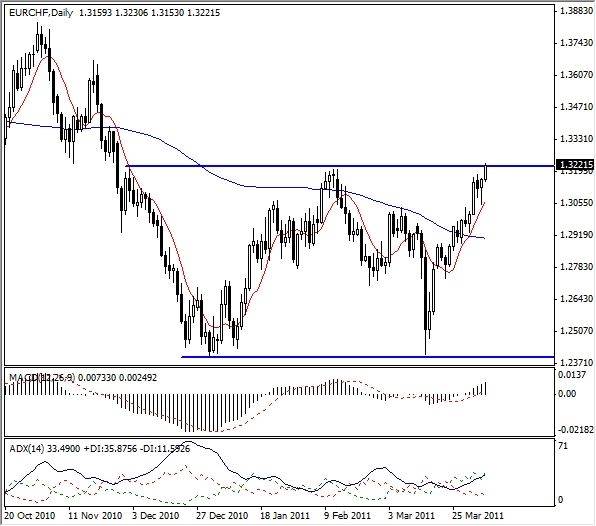 This is particularly visible against the currencies where the CHF reached all time extremes, such as the US Dollar, the British Pound and the Euro. On the daily chart of the EUR-CHF, we can see the rally from 1.2409 to the current 1.3220. This happens to be a very important resistance level tested twice before.
This is particularly visible against the currencies where the CHF reached all time extremes, such as the US Dollar, the British Pound and the Euro. On the daily chart of the EUR-CHF, we can see the rally from 1.2409 to the current 1.3220. This happens to be a very important resistance level tested twice before.A breakout above this level would signal a continuation in this rally, suggesting the next objective at 1.3675 or so. Perhaps more importantly, though, it would complete the double bottom reversal pattern in the EUR-CHF, likely reversing the long-term bear market in this pair.
For that, we must see a daily close above the resistance, which has not happened yet. In addition, one should be mindful about the ECB rate decision on Thursday. Markets are clearly expecting a hike in rates, something that the central bank hinted at before. If there is no action, the Euro could suffer for a while. In the long run, though, the EUR-CHF is poised to move higher.
http://www.dailyforex.com/forex-technical-analysis/2011/04/EUR-CHF-Poised-to-Go-Higher/7624
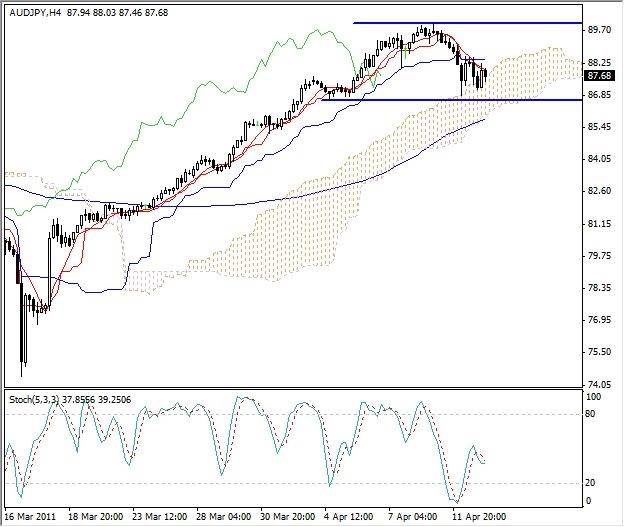 Last week the AUD-JPY reached a high for this price swing at 90.02. Since then it had drifted lower, including a relatively sharp sell off on Tuesday, which pushed it down to 86.85. That level is an intermediate term support, established by a minor low couple of weeks ago.
Last week the AUD-JPY reached a high for this price swing at 90.02. Since then it had drifted lower, including a relatively sharp sell off on Tuesday, which pushed it down to 86.85. That level is an intermediate term support, established by a minor low couple of weeks ago. What's Happening Now?
As of right now, the intermediate term chart appears to be forming a trading range, very typical after a strong trend. It is hard to say, what the outcome will be – continuation of the rally or a correction of larger magnitude. That will be decided when the AUD-JPY moves through either the support or the resistance.The support appears to be firm, with not only the previous low serving in this role, but also the Ichimoku cloud and the 100 SMA located nearby. On the upside, the recent high provides resistance at 90.02. Since this is psychologically important level (round number), the resistance might be solid, too, possibly locking the AUD-JPY into this trading range for some time.
http://www.dailyforex.com/forex-technical-analysis/2011/04/AUD-JPY-Forming-A-Trading-Range/7676
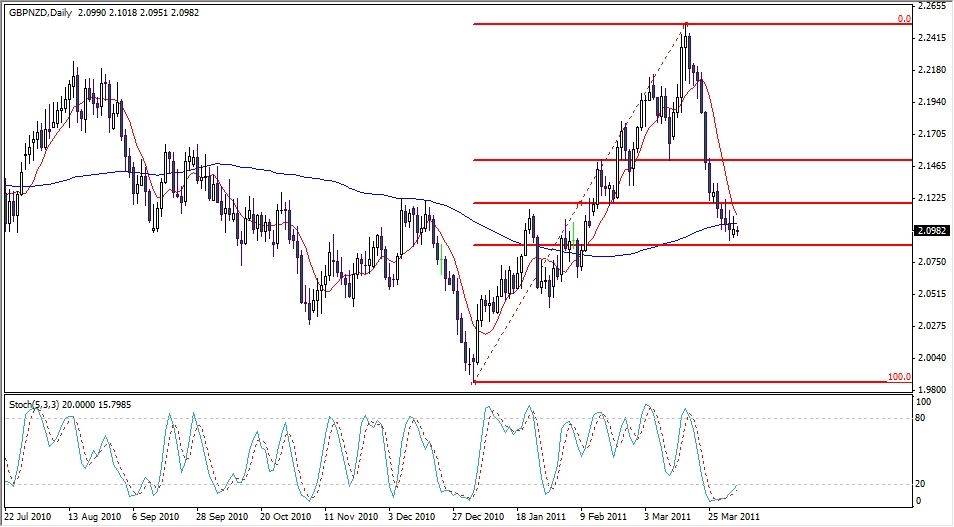 In case of the GBP-NZD the current move is even larger, about 1600 pips, as measured from the high of 2.2520 to the low of 2.0915 reached last Friday. However, the daily progress is getting smaller and smaller, indicating that the momentum maybe running out.
In case of the GBP-NZD the current move is even larger, about 1600 pips, as measured from the high of 2.2520 to the low of 2.0915 reached last Friday. However, the daily progress is getting smaller and smaller, indicating that the momentum maybe running out.When looking at the daily chart of the GBP-NZD, we can classify this sell off as a corrective move within the larger, primary bullish price swing, from 1.9858 to 2.2520. In this context, we could expect the price to reverse and resume the uptrend soon.
What's Happening Now
Currently, the GBP-NZD is at a possible important support. That is the proximity of the 62% Fibonacci retracement level, where reversals often happen. Here the price is also at the 100 SMA, another technical support/resistance tool.In addition, the Stochastic Indicator is at extremely low reading, meaning short-term oversold conditions. Altogether, the daily chart of the GBP-NZD suggests that the 2.0900-2.1000 area is vulnerable to a reversal and the price could turn around here, resuming the uptrend.
http://www.dailyforex.com/forex-technical-analysis/2011/04/GBP-NZD-Testing-Important-Support/7611
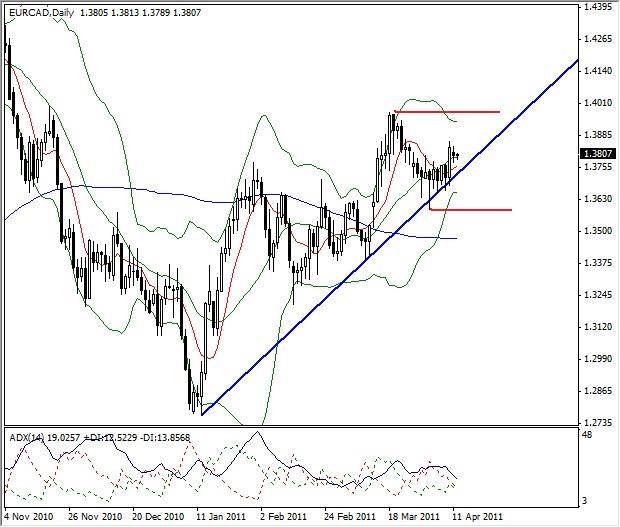 This rally in the rally has not been effected all of its crosses. The EUR-CAD, for example has hardly moved at all over the past two weeks, and settled into a consolidation. The price tested the trendline, even dipped under it, but so far remained above, preserving the uptrend.
This rally in the rally has not been effected all of its crosses. The EUR-CAD, for example has hardly moved at all over the past two weeks, and settled into a consolidation. The price tested the trendline, even dipped under it, but so far remained above, preserving the uptrend. What Can We Learn From This?
It is clear that the EUR-CAD “waits” for a catalyst to push it either way. The price is in a holding pattern, with technical indicators confirming it. We can see that the Bollinger bands have contracted sharply, which typically happens before a larger move starts. That is what we should expect here soon, but in which direction?Breaking either the nearest support or resistance will likely decide the next market move. However, since the trendline is intact, continuation of the uptrend is a little more likely. The ADX should also turn up for additional confirmation. It is possible for the EUR-CAD to start moving again as early as Tuesday, after the Bank of Canada policy meeting.
http://www.dailyforex.com/forex-technical-analysis/2011/04/EUR-CAD-Consolidation-Could-End-Soon/7664
Two weeks ago, the pair had tested the 0.88 level, a key level in this pair. Although it failed, we found ourselves pushing above it the following week. This past week has had us fall again, only to bounce northward as buyers stepped in. It should be noted that there was a massive downtrend line that had gotten violated two weeks ago. This trend line was not only broken, but at the lows of this week was retested and confirmed as support.
Following Trend Lines
When looking for a breakout, the more conservative traders will wait for a pullback and a retest of the trend line to find if it will reverse courses. As the trend line was such heavy resistance since November of 2008, it should be expected to serve as fairly strong support as well. As we push higher, the 0.88 level is proving to be a pivotal level yet again as it attracts so many buyers and sellers.By looking at this trend line however, it appears that the bulls are starting to take control again, and we may have seen a capitulation of sorts by the sellers. The trend appears to be reasserting itself as this pair will certainly target the 0.90 level and then on to the 0.92 and 0.97 areas as well. Of course, if the pair breaks lower than the trend line, or the 0.87 level - we would have a false breakout of sorts.
The fundamentals also line up for this move, as the European Central Bank is getting ready to raise rates this week for the first time in a couple of years. This should be very bullish for the Euro in general, and should play out to be quite a healthy move in this pair. Of course, the real focus this week will be on the statement that the central bankers make as to whether or not more rate cuts are likely. However, it appears that the fundamentals and the charts are starting to line up which may be a sign of things moving back to some sense of normalcy. This pair shouldn't be any different.
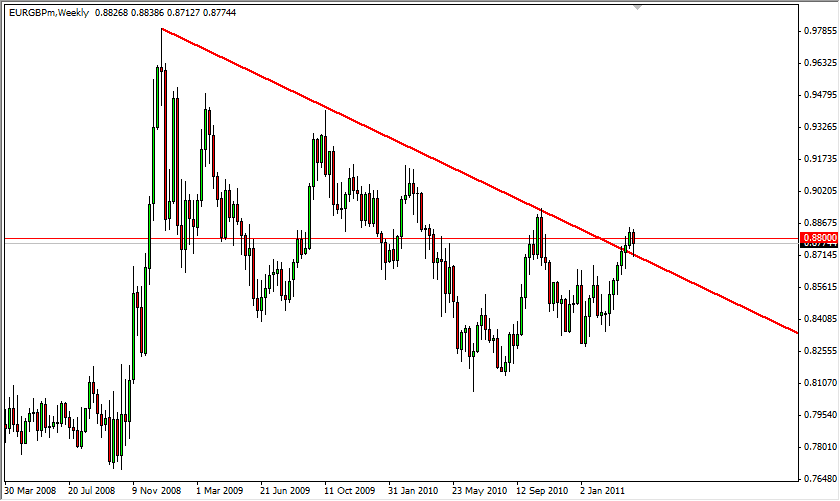
http://www.dailyforex.com/forex-technical-analysis/2011/04/EUR-GBP-Breaking-Recent-Downtrend/7632
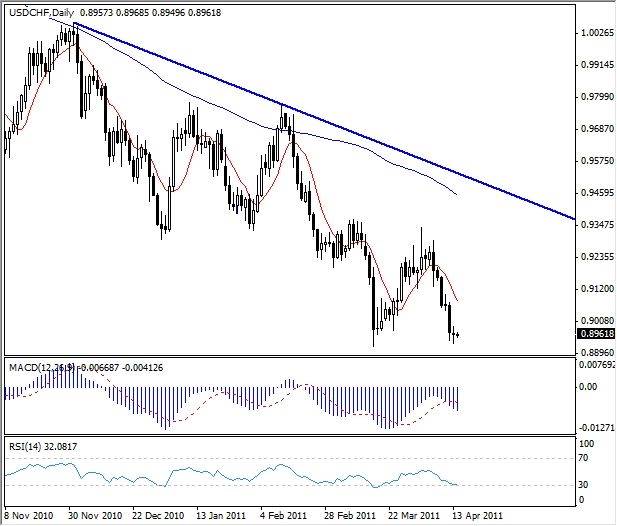 Currently the price is about to test that record low. On Wednesday, the USD-CHF dropped to 0.8928 in quiet trading. While it was a slow day not just for this pair, but for most other currencies as well, a slowdown so near an important level like here signals uncertainty and advises caution.
Currently the price is about to test that record low. On Wednesday, the USD-CHF dropped to 0.8928 in quiet trading. While it was a slow day not just for this pair, but for most other currencies as well, a slowdown so near an important level like here signals uncertainty and advises caution. Chances are that the price will encounter a strong support in this area. We can see the last daily candlestick forming a doji, which, following a bearish day could be a harbinger of a corrective move. Doji patterns require confirmation, so a bullish candlestick is needed now.
Other technicals also support a correction from this level. Both the RSI and the MACD indicators could have the makings of divergences. Since the price has not made new low yet, these are still only potential divergences. However, all these factors increase chances for the USD-CHF to find a support at the all time low, if only temporarily.
http://www.dailyforex.com/forex-technical-analysis/2011/04/USD-CHF-Is-Testing-the-Record-Low/7683
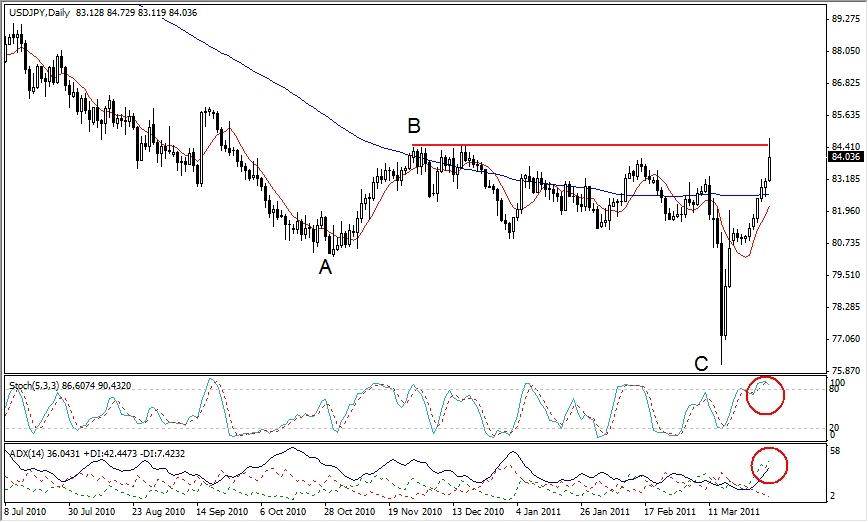 During the last few days, the USD-JPY made additional gains, rallying to 84.72 on Friday. In the process, it breached an important resistance of 84.50, established by a high (B). That happens to be latest minor high within the downtrend, the highest point between the last two lows (A and C). Moving through this resistance makes a strong argument for a major trend reversal.
During the last few days, the USD-JPY made additional gains, rallying to 84.72 on Friday. In the process, it breached an important resistance of 84.50, established by a high (B). That happens to be latest minor high within the downtrend, the highest point between the last two lows (A and C). Moving through this resistance makes a strong argument for a major trend reversal. For that, however, we need to see a close above 84.50, something what the daily chart of the USD-JPY failed to do so far. The recent price run up has been so fast, that it could be overbought on short-term bases, as suggested by the Stochastic Indicator. A slight pull back or a consolidation is very likely now.
Looking a little farther ahead, 1-2 weeks or so, the newly forming uptrend should continue. The ADX is rising, but at a reading of 34 is not overbought or overextended – that comes at above 50. If the price moves back above 84.50, we could see a real bull market, taking to USD-JPY to 88.00 and perhaps even 90.00 within weeks.
http://www.dailyforex.com/forex-technical-analysis/2011/04/What-Is-Next-For-USD-JPY/7600
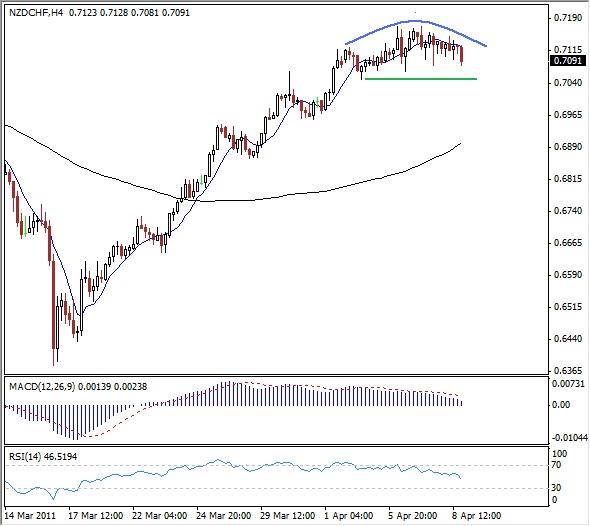 In case of the NZD-CHF, this could be corrective move within the large bearish price swing that preceded it. This pair sold off from a high of 0.7475 in February, to the recent low of 0.6380. Since then, of course, we had the current rally to 0.7172.
In case of the NZD-CHF, this could be corrective move within the large bearish price swing that preceded it. This pair sold off from a high of 0.7475 in February, to the recent low of 0.6380. Since then, of course, we had the current rally to 0.7172. Is a Rounded Top Forming?
The price action as seen on the intermediate term chart has stalled, spending a week within a range of about 100 pips. It is also assuming a shape of a rounded top, which a reversal formation. Rounded tops, once completed, tend to have staying power, meaning that they are as reliable as chart patterns get.To complete this rounded top, the NZD-CHF must move under 0.7045, which is a pivot point here, established by a minor low on April 4. The MACD and the RSI are already drifting south, confirming a possibility of a reversal. If this rounded top is completed, the NZD-CHF could easily drop 150-200 pips.
http://www.dailyforex.com/forex-technical-analysis/2011/04/Possible-Rounded-Top-in-NZD-CHF/7647
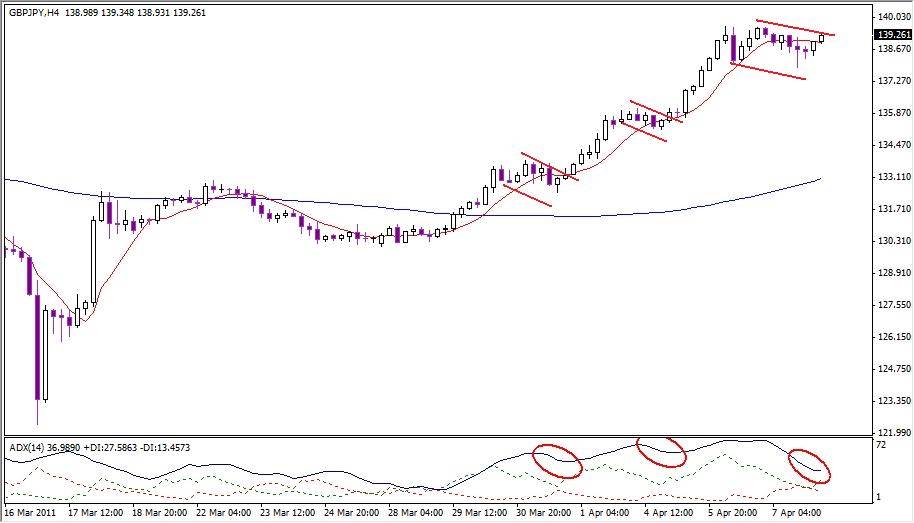 One of them was the GBP-JPY, the ever-popular “beast”. For about a week following the intervention, it settled into a sideways pattern, before the uptrend developed. Over the last two weeks the GBP-JPY rallied about 1000 pips with very little pause. During that time, we can find only two brief slow-down periods on the intermediate term chart, both of them in the form of a flag.
One of them was the GBP-JPY, the ever-popular “beast”. For about a week following the intervention, it settled into a sideways pattern, before the uptrend developed. Over the last two weeks the GBP-JPY rallied about 1000 pips with very little pause. During that time, we can find only two brief slow-down periods on the intermediate term chart, both of them in the form of a flag. What's Going on Now?
Currently the price is forming yet another one of these patterns. Flags are continuation formations, so we could expect another move up, perhaps as high as 142.00. This particular flag is not as tight as the previous examples, but this is typical in an advanced trend. Of course, this also means that flags at this stage also have somewhat higher failure rate.If the price breaks out to the upside, we would like to see a confirmation using other tools. During this uptrend, the ADX has been working just fine in this role by showing an uptick on a move. We would like to see the same behavior here, with the ADX turning north. This would improve chances for another good size swing in the GBP-JPY.
http://www.dailyforex.com/forex-technical-analysis/2011/04/GBP-JPY-Forming-Another-Flag/7642
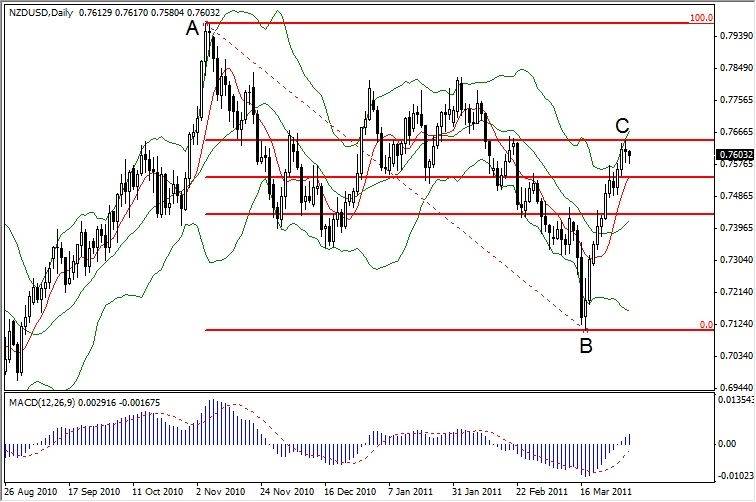 This particular price swing may be ending. Numerous technical factors suggest a possibility of a reversal/correction soon. When looking at the daily chart of the NZD-USD, we can see how the recent run up fits within the larger picture. Thursday’s high of 0.7645 (C), happens to be at 62% Fibonacci retracement level of the major swing down from 0.7974 (A) to 0.7108 (B). Markets often reverse at the 62% level, and that could be the case here as well.
This particular price swing may be ending. Numerous technical factors suggest a possibility of a reversal/correction soon. When looking at the daily chart of the NZD-USD, we can see how the recent run up fits within the larger picture. Thursday’s high of 0.7645 (C), happens to be at 62% Fibonacci retracement level of the major swing down from 0.7974 (A) to 0.7108 (B). Markets often reverse at the 62% level, and that could be the case here as well.Fast pace of the latest advance also pushed it just outside the upper Bollinger bands, meaning that the price is out of norm. We can see what happened in the past when this situation occurred – a correction of some magnitude in almost every instance.
In addition, the daily candlesticks are bearish. The last complete one is a doji, or a small body variation of one, indicating indecision and possible reversal. If the current candlestick is bearish at closing time, a probability for a pull back/correction in the NZD-USD would become even stronger
http://www.dailyforex.com/forex-technical-analysis/2011/04/NZD-USD-Rally-May-Have-Run-Its-Course/7595
For the North American session, eyes were all on budget negotiations and data releases were only second tier so relative yields played a large part in cementing direction. For the record, U.S. wholesale inventories came in as expected, up 1.0% and unchanged from a revised previous figure. Wall St finished the week on a soft note resulting in an almost flat performance on the week. Canada’s employment data was mixed with a drop in unemployment mostly as a result of a fall in the participation rate while headline employment change looked on the soft side but masked a strong increase in full-time jobs.
It is a slow start to the week on the data front in Asia and the session was spent consolidating the gains made against the U.S. dollar on Friday. News that the U.S. government narrowly avoided a shutdown had little noticeable effect. In weekend events, we have seen an escalation in tensions in the Middle East with protestors killed in Yemen, Syria and Egypt but the only impact was felt in oil markets.
China released trade data for March during the weekend and printed a small trade surplus, +$0.14 bln, which was a big surprise considering consensus was for a deficit of $3.35 bln. While March data shows a strong rebound from February’s $7.3 bln deficit, it still meant that in Q1 China recorded its first quarterly deficit in 7 years (-$1.02 bln). Has it helped global imbalances?
The European session is also relatively mundane on the data front with CPI data from Denmark and Norway and industrial production from France and Italy featured. There are no data releases for North America but we have speeches from the Federal Reserve’s Dudley and Yellen and the European Central Bank’s Weber.
http://www.dailyforex.com/forex-fundamental-analysis/2011/04/US-Government-Narrowly-Avoids-a-Shutdown/7656
The bank has already injected the equivalent of 10% of the nation’s GDP ($439 billion) into the financial markets since the crisis struck. The move was sufficient to restore confidence to the markets in Japan and around the world and, after an intervention from other G7 members, ward off a bull-run on the Yen. In recent days, the Yen has weakened against other major currencies and is currently trading at 121.4747 against the Euro, its weakest level since May last year.
Things to Expect Looking Forward
Given the magnitude of the problems facing Japan (and the Japanese recovery was considered fragile even before the disaster struck), the Bank cannot solve the problems on its own. Analysts suggest that the government may take steps to ensure that reconstruction efforts move ahead as swiftly as possible which would help macroeconomic conditions. The wisdom of the Bank underwriting a government bond issue to fund reconstruction activities has been questioned since it could undermine confidence in its monetary policy. It is anticipated that the Bank will announce measures to assist businesses affected by the crisis with fast-tracked, cheap credit. The Bank has also made it clear that its quantitative easing activities will continue as a a mechanism to ensure greater liquidity in Japanese financial markets.Revised survey data shows that business sentiment has fallen from a value of plus six before the crisis, to minus two in its aftermath.
http://www.dailyforex.com/forex-fundamental-analysis/2011/04/Bank-Of-Japan-Considers-Its-Options/7627
Demand in Europe and the USA, critical Chinese export markets, continues to be sluggish as the regions slowly emerge from the financial crisis. China is hoping to stimulate domestic demand and be less reliant on its exports, but it is also having to take steps to rein-in inflation and prevent a property bubble from bursting.
The consequences of the recent Japanese natural disaster are also likely to have an impact on China since Japan is China’s largest importing partner. It remains difficult to determine the knock-on effect of the Japanese earthquake in her trading partner’s economies and the picture will only emerge after the full extent of catastrophe on Japan’s own economy becomes clearer.
A Look at China's Recent Past
China was quick to emerge from the global recession and has produced spectacular growth in comparison with the world’s other leading economies. The rise of China as a major economic power has been export-led. It remains to be seen whether the Q1 figures will be just a blip, or if there has been a more fundamental readjustment of her trading balance over the shorter term.China remains under criticism for keeping its currency artificially low. Whilst some movement has been seen over the past twelve months, the appreciation of some 4% against the US Dollar needs to be put in context. The Dollar is coming off historic lows against the Yen and has depreciated by 7.8% against the Euro since this time last year. If the effects of the sovereign debt crisis in Europe are taken into account, it becomes clear that the Yuan is being manipulated.
http://www.dailyforex.com/forex-fundamental-analysis/2011/04/China-Posts-Rare-Trade-Deficit/7675
According to Eurostat, the level of unemployment within the 17 countries which use the Euro has fallen to below 10% for the first time in more than a year. The figure for February came in just below the 10% mark at 9.9%. A closer analysis of the data shows that the unemployment picture within the Eurozone is very heterogeneous. In the Netherlands, just 4.3% of the workforce is unemployed whereas in Spain 20.5% of the population of working age are looking for work. In Germany, the powerhouse economy of the Eurozone region, unemployment stands at 6.3%. Across the Eurozone as a whole, some 15.8 million citizens are currently without work.
Data released in the USA last week shows that unemployment there has fallen for the second consecutive month. The figure is the best seen in America for two years and reveals that 8.8% of the workforce is currently unemployed (March data). The figure has eased from 8.9% in February and has improved by more than one percent over the last four month period. The private sector was responsible for the creation of most of the new jobs, a situation which is likely to continue as America tries to reduce its deficit.
http://www.dailyforex.com/forex-fundamental-analysis/2011/04/Unemployment-Rates-Fall-In-Europe-and-USA/7616








